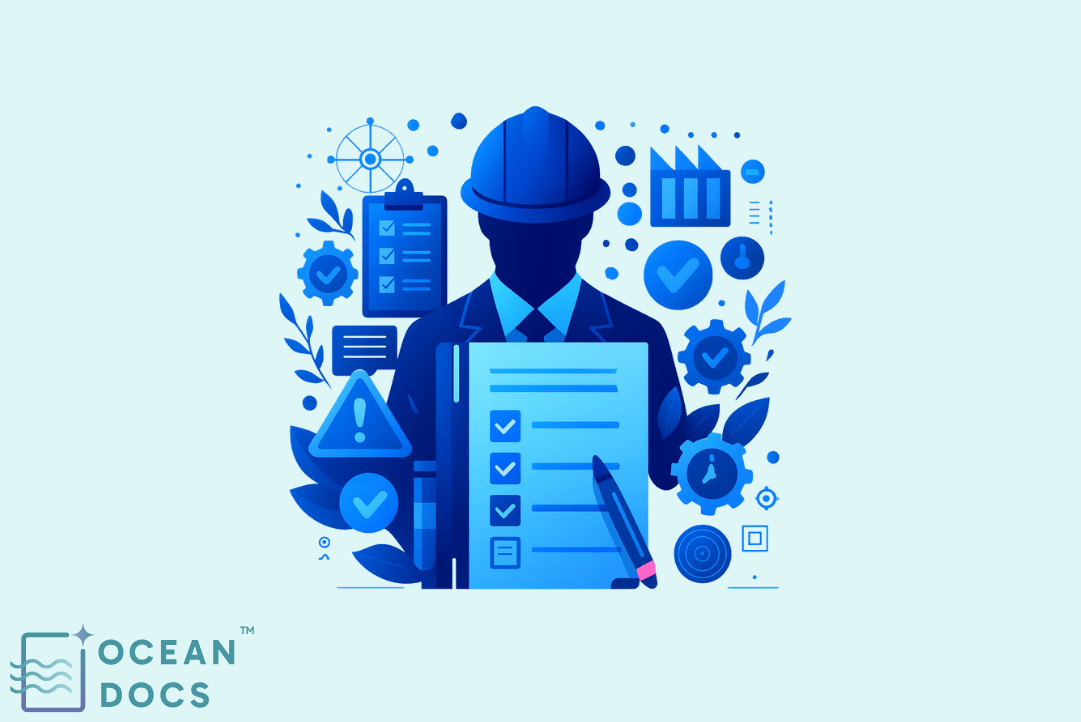
How OceanDocs AI Prepares Your Documents for Port Visits with HSEQ Focus
October 1, 2025 By OceanDocs AI
Preparing documents for a port visit is more than ticking boxes. In global shipping, where safety, compliance, and environmental care define readiness, HSEQ (Health, Safety, Environment, and Quality) standards take center stage. Delays, fines, or failed inspections often trace back to disorganized or outdated documentation. With OceanDocs AI, operators can stay inspection-ready by streamlining shipping documents and aligning them with maritime regulations.
Why Document Preparation Matters Before a Port Visit
Port Authorities carry out detailed inspections to ensure safety, environmental, and operational compliance. For ship operators, accurate and updated maritime documentation speeds up clearance and avoids costly disruptions.
Compliance is not optional. Certificates and records tied to the IMDG Code (International Maritime Dangerous Goods), LSA Code (Life-Saving Appliances), and Ballast Water Management protocols must be current. Meeting HSEQ principles not only reduces risks but also builds trust in operations.
Core Documents You Need
Before arrival, ensure these documents are in order:
-
Certificates of Compliance: Proof that the vessel meets safety and environmental standards.
-
Cargo Manifests: Lists of goods onboard, especially required for dangerous cargo under the IMDG Code.
-
Crew and Passenger Lists: Verified details against immigration rules.
-
Safety Equipment Certificates: Compliance with the LSA Code.
-
Ballast Water Management Records: Logs on treatment and disposal for environmental protection.
-
Maintenance and Inspection Records: Evidence that onboard systems meet HSEQ requirements.
Steps to Prepare Your Documentation
-
Review Maritime Regulations
Cross-check relevant compliance requirements for your voyage and cargo. -
Organize with Document Intelligence
OceanDocs AI helps structure and categorize shipping documentation by type, date, and compliance needs. -
Update Compliance Records
Outdated or incomplete certificates delay inspections. OceanDocs AI ensures that all versions are current. -
Coordinate with Port Authorities
Confirm submission formats, inspection routines, and any updates to compliance rules. -
Leverage Marine Technology
OceanDocs AI scans maritime documentation, flags missing details, and highlights risks before your vessel reaches port.
Best Practices for Smooth Port Inspections
-
Follow HSEQ Principles: Embed health, safety, environment, and quality standards into every process.
-
Maintain Digital + Paper Copies: Digital files speed retrieval, while paper copies act as fail-safes.
-
Keep Crew Informed: Train crew on where documents are stored and their inspection importance.
-
Conduct Internal Audits: Regular checks identify issues before Port Authorities do.
How OceanDocs AI Helps
Marine technology has shifted how documentation is handled. OceanDocs AI supports operators with:
-
Smart Extraction: Pulls key data from scanned documents.
-
Compliance Matching: Aligns entries with IMO and port-specific checklists.
-
Risk Alerts: Warns if an upcoming inspection may fail due to outdated or missing records.
By automating preparation, OceanDocs AI reduces human error, saves time, and enhances operational safety — all while maintaining high HSEQ standards.
Conclusion
Document preparation is about more than avoiding delays. It demonstrates commitment to safety, compliance, and efficiency. With OceanDocs AI, ship operators get centralized, searchable, and inspection-ready shipping documentation that ensures smoother port visits, minimized downtime, and stronger global compliance.